The string quartet is recognised as the purest of musical forms, providing the composer with a definitive genre through which to express their most profound musical thoughts. The most prolific and productive period for the string quartet was the period between the late eighteenth century, encompassing the pioneering and consolidatory works of Haydn and Mozart, and the first half of the nineteenth century and the monumental works of Beethoven and the works of the early romantics Schubert, Mendelssohn and Schumann. Throughout this period of development the "anxiety of influence" (Bloom, 1992) can be seen as th e motivating force of successive generations of composers, commencing with Beethoven's backward glances at the acheivements of Haydn and Mozart, and then Schubert, Mendelssohn and Schumann's self-conscious preoccupation with the mammoth works of Beethoven.
"Viennese musical life bought the classical string quartet to fruition in the later years of the eighteenth century" (Grove Vol..18, p.280). It also provided the environment in the first half of the nineteenth century for the birth of a "new expressiveness, new organising principles, and a new aesthetic philosophy "(Ulrich 1966,p.264-5), which became known as Romanticism. In its development the works of Ludwig Van Beethoven (1770-1827), Franz Schubert (1797-1828), Felix Mendelssohn-Bartholdy (1809-1847) and Robert Schumann (1810-1859) led the way.
The seventeen string quartets of Ludwig van Beethoven (1770-1827), which "mark the point of departure for many composers of the nineteenth century" (Grove, Vol.18,p.281), may be divided into three distinct periods. Firstly, the Opus 18 quartets, written in his first maturity around 1800; secondly,the middle period quartets written between 1807 - 1810 which include the Razumovsky quartets; and finally, his late period between 1824 to 1826 which includes works written in his last months of life.
The six quartets of Opus 18, although written within the conventional framework established by the Viennese masters Mozart and Haydn, already begin to reveal the profundity and expansion of scal e which is to mark the quartets of his middle and late periods (Grove Vol..18, p.281). Quartet No. 1 in F major contains many examples of the "generating power of the individual motive" (Ulrich 1948, p.247), Beethoven's first subject from the first movement has its genesis in the short opening motive (Ex. 1) which dominates the entire movement, in fact in occurs 102 times in all. The use of counterpoint, which was to become almost a preoccupation in his later writing, is also evident in Opus 18 ("The Beethoven Compendium 1991, p.233).

Example 2 taken from the development section shows Beethoven's use of the opening motive in a contrapuntal format.
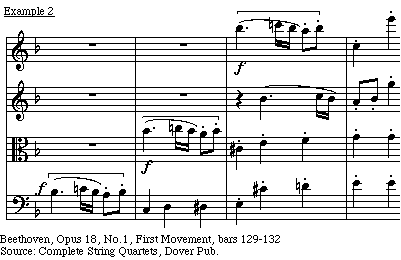
Beethoven was very fond of sudden dynamic contrasts. The use of the sforzando on the week beat is a technique used quite frequently (Radcliffe 1965,p.38), a typical example is found in the Trio of Opus 18 No.5 (Ex.3)
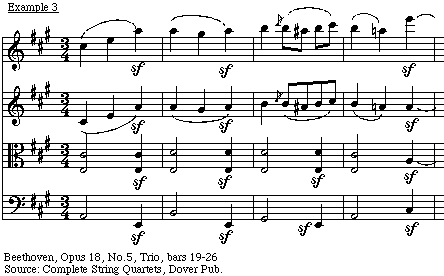
Six years elapse between the Opus 18 quartets and the three Razumovsky quartets that make up Opus 59, which were completed between April and November of 1806 and dedicated to the Russian ambassador to the Imperial Court in Vienna, Count Razumovsky (Kramer,R.1980, p.232). The enormous forward stride marked by the composition of the Eroica symphony (1804) is evident in this series of compositions, which along with the Harp quartet Opus 74 (1809), and the Quartetto serioso Opus 95 (1810), make up the quartets of Beethoven's middle period. This period in Beethoven's work "marked the point of departure for many later composers of the nineteenth century" (Grove Vol.18, p.281).
First movement sonata form predominates as the main structural vehicle for the middle period quartets, Beethoven seldom using the rondo form after 1802 (Cobbett 1963, Vol.1, p.88). The slow movements of this period are scored with "richly sonorous and elaborated textures"(Grove Vol.18, p.281), and counterpoint assumes a new dramatic purpose. This last point is most apparent in the finale of Opus 59 No.3 (1806), where the fierce driving quality of the counterpoint is completly free from the text book rigidity so often apparent in the works of lessor composers. It is obvious that Beethoven ; was not concerned with writing a model fugue, but with expressing "superhuman vitality" (Ferguson 1977, p.106).
Cobbett (1963, Vol..1, p.96) suggests that the Quartetto Serioso Opus 95 (1810) is "the most typical of what we recognise to be the Beethoven spirit", full of contrasts, struggling figures, diminished seventh chords, sforzandos. Beethoven, aware that the revolutionary concepts in this quartet may not be immediately accepted by the public, wrote to a friend, "The quartet [Opus 95] is written for a small circle of connoisseurs and is never to be performed in public" (Anderson 1961, Letter no.664)'Beethoven now views the fugue as a vehicle for his most profound musical thoughts and no longer as a technical means'
Fourteen years separate the Quartetto Serioso Opus 95 and the six that make up Beethoven's final period. These works with their "violent contrasts, their mixture of the earthy and the sublime, the serio Ïus and the comical, had already gone far towards creating a universe in their own genre" (Grove Vol.18, p.281).
Structurally the final quartets of Beethoven are quite diverse. He adopted five, six and seven movement schemes for his Opus 132, 130 and 131 respectively, but then returned, in October of 1826, to the conventional four movement form for his last quartet Opus 135. This work, which Beethoven entitled Dyer schwergefasste Entschluss (the hard -won decision), is shorter than the other late quartets and features a final movement based on two motives which provide the thematic material for the work, one set to Muss es sein? (Must it be?), and the other Es muss sein? (It must be) (Kerman 1967, p.363). The implications of Beethoven's final dramatics have been the subject of much speculation and debate (Ferguson 1977, p.130-131).
Between the years 1812 and 1826 Franz Schubert (1797-1828) wrote fifteen string quartets. The first twelve of these, wr itten during his youth for performance at home gatherings, failed to display the same maturity present in his Lieder and piano music of the same period (Cobbett 1963,p.354). Ulrich (1966, p.269) states, "in his early works Schubert was not striving to imitate Classical form; his efforts were directed toward an expansion of colour possibilities, toward a discovery of new textures and a warm lyricism".
Cobbett (1963, p.357) suggests that "a whole world divides the youthful quartets from the quartet fragment of 1820". This work, Quartettsatz in C minor, is written with a new sort of intensity and consists of a single movement which clearly demonstrates Schubert's ability to incorporate his lyrical genius into the sonata form framework. Commencing with an eight bar fugato style introduction based on a two bar subject, the sinister beginning is then transformed at bar 13 into the descending first subject. (Ex.5)
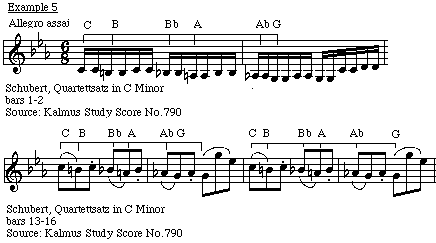
The second subject, commencing at bar 94, is one of Schubert's superb lyrical melodies given to the first violin, and under-scored in the viola by a figure born out of the first subject.
Schubert differs from Beethoven in that he "no longer regards the individualisation of the four parts as the goal itself" (Cobbett 1963, p.354). He was fond of grouping the instruments in twos and playing them off, one against the other. What Schubert tries to achieve with this technique is an arrangement of parts in layers as in orchestral technique (Cobbett 1963, p.354). (Ex. 7)
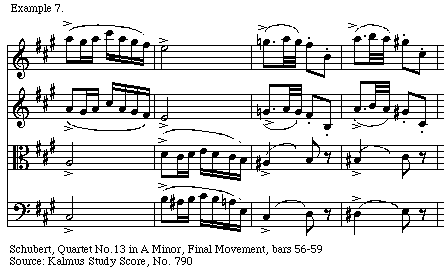
Another characteristic of Schubert's style was the use of accompaniment patterns as in his Lieder (Grove Vol..18, p.282). Example 8 from the A minor quartet (1824) has the figure in the second violin.
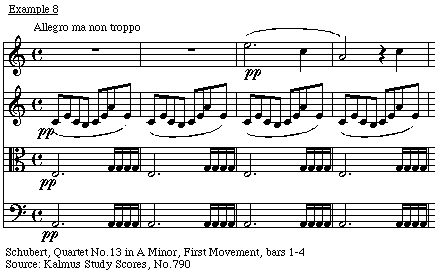
The music of Felix Mendelssohn-Bartholdy (1809-1847) reflects the privileged upbringing both Felix and his sister Fanny received. Felix was insulated, through an exclusive private education, from the harsh realities of the revolutionary period in which he grew up. His music is a "model of design and of discrimination of colour" (Ferguson 1977, p.156), absent is the reflection on human suffering and despair that mark the works of both Beethoven and Schubert.
Mendelssohn wrote six string quartets between 1829 and 1850, their texture was quite often orchestral in style, for example the prominent tremolos in the opening of the D major quartet(1837) and the F minor Quartet(1847), which aim at intensity, "only capture a sense of spurious industry"(Grove Vol..18, p.281-282). The slow movement of the Em quartet Opus 44, No.2 (Ex. 9), with its lyrical melody accompanied by pianistic figurations, is virtually a song without words (Grove Vol.18, p.282). As with most composers living in the shadow of Beethoven, the influence of the great man is evident in a number of his quartets. The E minor quartet Opus 12 (1829) features an introduction modelled on Beethoven's Harp quartet op.74, the F minor quartet Opus 80 (1847) expounds a strong Beethoven influence throughout (Cobbett 1963).
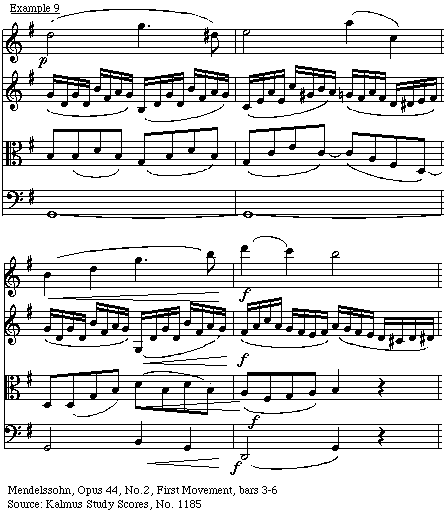
The three string quartets of Robert Schumann (1810-1859), in many ways "among the mos t perfect of all the products of his genius" (Cobbett, Vol.2, p. 369), were written in the yaer 1842. Schumann prepared himself for his quartet writing by devoting two months during this year 1842 to the study of the scores of Mozart and Beethoven (Cobbett,Vol.2 ,p. 369).
Schumann's quartet writing was influenced by his years of piano training and his lack of familiarity with stringed instruments (Cobbett, Vol.2, p. 371). For example the first movement of Opus 41 No.3 (Ex.10) uses a typical pianistic off-beat figuration. These passages were met with hostility by the string players of his day, although subsequent generations have learned to play these passages and have "attuned to their beauties" (Cobbett, Vol.2 , p. 371).
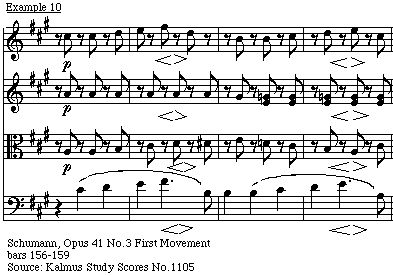
The development of the string quartet reached its pinnacle with the late quartets of Beethoven, the subsequent works of Schubert, Mendelssohn and Schumann and their contemporaries following in the shadow of Beethoven, whilst adding certain personal characteristics to the genre failed to add either structurally or conceptually to his monumental achievements. The most obvious reasons for this situation are two-fold; firstly, the genius of Beethoven encompassing its immense range of emotion, intensity of thought and economy of application, found an ideal medium in the string quartet which was unmatched by the following generation; and secondly, the preoccupation during the Romantic period with the grandiose conception of the expanded orchestra and its two most important vehicles, the symphony and the symphonic poem, was incompatible with the conciseness and intimacy of the string quartet genre, therefore the medium became less attractive to composers as the nineteenth century progressed.
Anderson, Emily ,1961, The Letters of Beethoven, Macmillan & Co. Ltd., London.
Beethoven, Ludwig, Complete String Quartets, Dover Publications Inc., New York.
Bloom, H., 1973, The Anxiety of Influence: A Theory of Poetry, Oxford University Press, New York.
Cobbett's Cyclopedic Survey of Chamber Music, 1963, ed. Cobbett,W., Oxford University Press, London.
Ferguson, Donald, 1977, Image and Structure in Chamber Music, Da Capo Press, New York.
Kerman, J., 1967, The Beethoven Quartets, Oxford University Press, London.
Kramer, Richard, 1980, 'On the Autograph of Beethoven's Opus 59 No.1', in The String Quartets of Haydn, Mozart, and Beethoven:Studies of the Autograph Manuscripts, ed. Wolff,C., Harvard University Press, Cambridge, Massachusetts.
New Grove Dictionary of Music and Musicians, 1980, Ed. Sadie,S., Vo «l.18, Macmillan, England.
Mendelssohn, F., Four Quartets for 2 Violins, Viola and Cello, Kalmus Study Score No. 1185, Edwin F. Kalmus, New York.
Radcliffe, P. 1965, Beethoven String Quartets, Hutchinson & Co., London.
Schubert, F., Kalmus Study Score No. 790, Edwin F. Kalmus, New York.
Schumann,R., Three Quartets for 2 Violins, Viola and Cello, Kalmus Study Score No. 1105, Edwin F. Kalmus, New York. Thayer, Alexander ,1967,
Thayer's Life of Beethoven, rev. ed. by ElliotForbes, Vol.1, Princeton University Press, New York.
The Beethoven Compendium, 1991, Ed. Cooper Barry, Thames & Hudson, London.
Ulrich, H., 1948, Chamber Music, Colombia University Press, New York.
SHARE THIS PAGE!